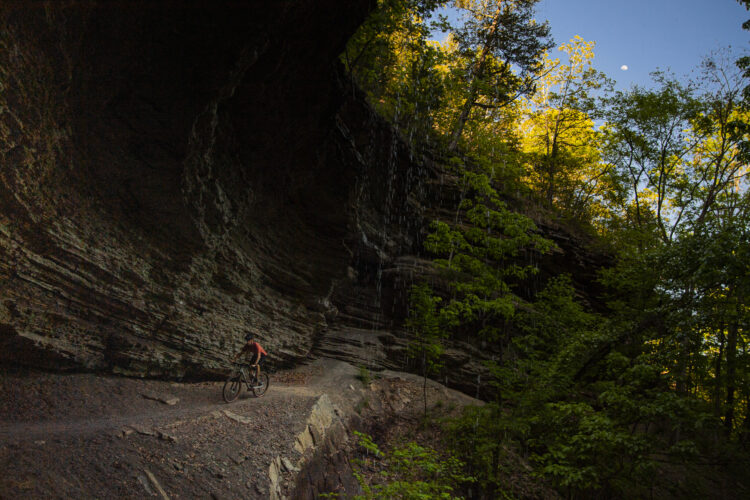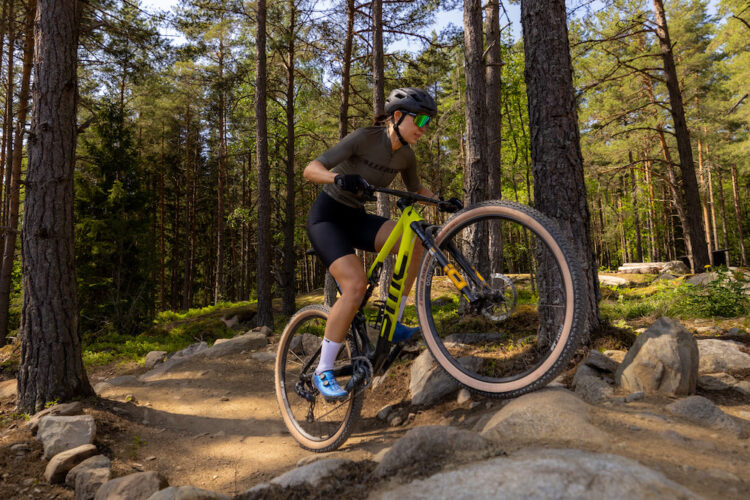
If you’re new to this wonderful sport or have recently pedaled alongside a true trail beginner then you know the woes of learning to shift gears. When should I shift? How many gears? Which way? These and more queries fill our minds as we learn the mechanics of mountain biking, all while dancing with body positioning and bike lean. It’s a lot. Below we share some ideas and ways of thinking about modern single ring MTB drivetrains out on the trail.
Which way is up down there? A one-by drivetrain uses a single chainring up front, whereas most mountain bikes once had two or three. Behind that single ring, the larger cogs on your 10, 11, 12, or 13-speed cassette make pedaling easier while climbing, and it will grow increasingly harder to pedal as you shift into smaller cogs. Another way to think of it is that the smaller cogs will make your bike roll further with the same amount of crank turns. That further rolling distance will make you go faster, and it requires additional force to get it up to speed. So, the little cogs are for going faster and the wide diameter pie-plates are for climbing slow and easy.
The smaller cogs are considered “higher” gears and the larger cogs “lower.” If a ride buddy mentions that they’re in a lower gear than you, they mean a larger cog. This configuration may seem counter-intuitive, but it’s likely simpler to accept it than to bonk your head against it.

An important piece to understand around gear selection is cadence: the speed at which the cranks turn. Cadence will shift depending on how your legs feel, what type of muscle your body makes, your speed, and how steep the slope is. In most cases, it’s good to have a higher cadence than a lower one so that you can use your muscles and aerobic system in tandem. As long as you’re not spinning so fast that it causes you to wobble around on the saddle and you feel comfortable with the spin you’re likely in a properly spinny gear with good cadence. Alternatively, if you have to bobble side to side and pull hard across the bike in order to pedal, the gear is possibly too high and your cadence too low. Low cadence can result in faster muscle fatigue and a sore back for a lot of riders. There are folks out there who always run the hardest gear possible with no issue, but the majority of us are better served by spinning an easy gear at a higher cadence to achieve the same speed.
Climbing is the number one time when you will want to click into those larger cogs. The easier spin and high cadence will allow you to climb steeper slopes and to get over obstacles without adding so much force that your rear tire slips or your stall out. If you come into a climb with a lot of speed it’s okay to keep that higher gear engaged until you need to sit and spin. If the climb is short enough you may be able to get away with one or two shifts before reaching the crest before shifting back into the higher gears. It’s best to shift as lightly as possible while climbing and to ease off the pedals a smidge when you hit the lever to be kind to the drivetrain. Too much pedal pressure while shifting can overload the transmission which occasionally results in a broken chain or disfigured cassette and chainring teeth.
Compressions or dips in the trail are some of the trickier spots to get the gears right no matter how well versed you are in the sport. When you launch into a larger dip it’s tricky to know how well you wil carry speed up the other side and what gear you will need when it’s finally time to start pedaling again. Typically, it’s good to start pedaling as soon as possible to better determine what gear you will need and when. Deep dips, where you enter with heaps of speed that have equally steep exits, can take practice to get the right gear, but once you’ve ridden a few of them you’ll find the rhythm and be able to better judge and execute shifts.

Downhill race bikes typically have smaller cassettes with 5-7 gears to choose from and for good reason. Those machines are heavy, so any weight reduction is welcomed, and they are only designed to go down so there’s no need to fiddle with climbing gears. Any time you’re headed downhill it’s good to shift into a smaller cog so you can pedal when needed. The faster you’re moving the higher gear you will need in order to put force into the drivetrain and go faster. I prefer to keep my chain on the highest gear possible while descending because the short pedaling bursts often consist of 1-2 rotations to power over an obstacle or a rise in the track, which can be done quickly with minimal muscle fatigue. On super steep and rocky tracks it can occasionally work well to put the chain on a larger cog to protect the derailleur since you won’t be pedaling. The derailleur cage is pulled in and forward in lower gears/larger cogs, moving it away from aluminum-hungry stones below.
When things become spicy on flatter trails it helps to find the spinniest gear you can manage. A low gear will allow you to maneuver through the minefield while applying less power to the cranks, which in turn should improve rear tire traction and allow you to move dynamically on the bike without fighting opposing pedal and impact forces. The same gearing method works well in deep sand and sloshy mud.
Hopefully, you found some of these concepts and methods helpful. Gear selection and cadence are as individual as any other element of riding, and you may find that mashing a massive cog all day suits you just fine. One of the fastest riders I know rolls with a cadence about half as fast as my own, and she has a very different muscular structure. If you have a different way of working with gearing, or advice for newer riders, please share it in the comments below. And, if you are a new rider with some burning questions please share them with us and we’ll do our best to stoke the singletrack!






I guess the Shimano drivetrains with hyper glide don’t need to be as conscious about shifting under load and Shimano actually promotes . Something new for me getting that drivetrain for the first time .